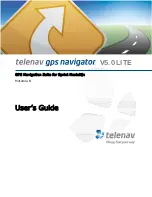
86
GPSMAP 2106/2110 Owner’s Manual
A
PPENDIX
>
LORAN TD S
YSTEM
Federal Users in the United States
Federal users can obtain MMSI assignments from their agency radio spectrum
management office. These procedures are currently under review by the NTIA
(National Telecommunications and Information Administration).
Users Outside the United States
Users can obtain an MMSI assignment from their telecommunications authority
or ship registry, often by obtaining or amending their ship station license.
Users in Canada
Industry Canada is responsible for assigning MMSI numbers to commercial and
recreational vessels. Information is available at the following Web site:
http://apollo.ic.gc.ca/english/mmsi.html
For more information regarding MMSIs visit:
http://www.navcen.uscg.gov/marcomms/gmdss/mmsi.htm
.
How Can Garmin Help You with DSC?
To receive Distress Calls or Position Reports, you must have a DSC-equipped
chartplotter as well as a VHF radio with DSC support. During normal, non-
emergency Position Report communication, Channel 70 (156.525 MHz) has been
set aside as the VHF/DSC digital call channel.
For a Distress Call, a mariner presses the MayDay button on the VHF radio.
The call transmits on an emergency channel with the MMSI number attached to
the call (if you have DSC support). Any DSC-equipped mariner (on sea or land)
within range can receive the call.
LORAN TD System
LORAN-C is a radio navigation aid operated and maintained in the U.S.A by
the United States Coast Guard. The LORAN (LOng RAnge Navigation) system
covers the entire U.S.A. and the U.S. Coastal Confluence Zone. From the
perspective of a mariner, the system is used for ocean and coastal navigation. It
can be used as a supplemental system for harbor and harbor approach navigation,
and it is used for inland navigation by recreational vehicles.
LORAN TD Feature
The LORAN TD (Time Delay) feature eases the transition from using LORAN
to using GPS. The GPSMAP unit automatically converts GPS coordinates to
LORAN TD for those who have a collection of LORAN fixes for favorite fishing
spots and other waypoints recorded as TDs. You can show your position as a
TD or enter waypoints as TDs. The expected accuracy from this conversion is
approximately 30 meters. When the unit is placed in the LORAN TD format
mode, it simulates the operation of a LORAN receiver. Position coordinates can
be displayed as TDs, and you can use all navigation functions as if the unit was
actually receiving LORAN signals.
Using the LORAN TD Format
When creating new waypoints using LORAN TD coordinates, you must set
the correct LORAN chain number and secondary stations in the Setup TD field
before storing a waypoint. You must have the correct chain number and the
secondary station identifiers to use this option correctly. These values vary for
each coordinate set or geographical location. Failure to enter correct information
could result in inaccuracies for the desired destination. After the waypoint is
stored in the unit’s memory, it always references the LORAN chain number
and secondary stations currently selected in the Setup TD field. If you enter a
different LORAN chain number, change the secondary stations or offsets in the
Setup TD field, the active waypoint information reflects those changes. Because












































